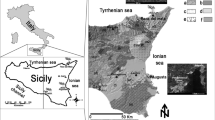Abstract
The concentrations of Ni, Cu, Zn, and Pb in human scalp hair of 281 individuals working in 10 Syrian industrial plants were determined using co-precipitation by ammoniumpyrolidinedithiocarbamate (APDC) method for total reflection X-ray fluorescence (TXRF) analysis. The results were compared to data obtained for a control group consisted of individuals working at the Syrian Atomic Energy Commission and also to data reported in the literature. The results given by the group of workers in battery plant showed that Pb concentration in human scalp hair samples were higher than those for control group, while some abnormal concentrations were obtained for Cu, Zn and Ni in cables, printing and battery plants, respectively. Normal concentrations of these elements were obtained for hair workers in olive oil, power stations, textile, and iron industrial plants. The relationships of Pb–Pb/Ni and Cu–Cu/Ni were plotted with correlation coefficients of 0.9937 and 0.9014, respectively. In general, the results showed that, the workers who were occupationally exposed to battery industrial pollution are at risk, followed by individuals in printing and cables industries, while the rest of workers in other industries are considered occupationally unexposed.
Similar content being viewed by others
References
Abugassa, I, Sarmani, S. B., & Samat, S. B. (1999). Multielement analysis of human hair and kidney stones by instrumental neutron activation analysis with the k0-standardization method. Applied Radiation and Isotopes, 50, 989–994.
Asfaw, A., & Wibetoe, G. (2004). Freon (CHF3)-assisted atomization for the determination of titanium using ultrasonic slurry sampling-graphite furnace atomic absorption spectrometry (USS–GFAAS): a simple and advantageous method for solid samples. Analytical and Bioanalytical Chemistry, 379, 526–531.
Carvalho, M. L., Brito, J., & Barreiros, M. A. (1998). Study of trace-element concentrations in human tissues by EDXRF spectrometry. X-Ray Spectrometry, 27, 198–204.
Dede, E. Y., Erten, H. N., Zararsiz, A., & Efe, N. (2001). Determination of trace element levels in human scalp hair in occupationally exposed subjects by XRF. Journal of Radioanalytical and Nuclear Chemistry, 247, 393–397.
Eltayeb, M. A. H., & Van-Grieken, R. E. (1989). Pre-concentration and XRF determination of heavy metals in hair from Sudanese populations. Journal of Radioanalytical and Nuclear Chemistry, 131, 331–342.
Faghihian, H., & Rahbarnia, H. (2002). Determination of trace elements in hair of some local population in Iran by instrumental neutron activation analysis. Journal of Radioanalytical and Nuclear Chemistry, 251, 427–430.
Fergusson, J. E. (1990). The heavy elects: chemistry, environmental impact and health effects. Oxford: Pergamon.
Katz, S. A., & Katz, R. B. (1992). Use of hair analysis for evaluating mercury intoxication of the human body: A review. Journal of Applied Toxicology, 12, 79–84.
Khuder, A., Bakir, M. A., Karjou, J., & Sawan, M. Kh. (2007). XRF and TXRF techniques for multi-element determination of trace elements in whole blood and human hair samples. Journal of Radioanalytical and Nuclear Chemistry, 273, 435–442.
Kolmogorov, Y, Kovaleva, V., & Gonchar, A (2000). Analysis of trace elements in scalp hair of healthy people, hyperplasia and breast cancer patients with XRF method. Nuclear Instruments and Methods in Physics Research A, 448, 457–460.
Lin, X. L., & Henkelmann, R. (2003). Contents of arsenic, mercury and other trace elements in Napoleon’s hair determined by INAA using the k0 method. Journal of Radioanalytical and Nuclear Chemistry, 257, 615–620.
Man, C. K., Zheng, Y. H., & Mak, P. K. (1996). Trace element profiles in the hair of nasopharyngeal carcinoma (NPC) patients. Journal of Radioanalytical and Nuclear Chemistry, 212, 151–160.
Martinez, T, Lartigue, J, Avila-Perez, P, Zarazua, G, Navarrete, M, Tejeda, S, et al. (2004). Determination of trace elements in blood samples by TXRF analysis. Journal of Radioanalytical and Nuclear Chemistry, 259, 511–514.
Matusiewicz, H., & Kopras, M. (2003). Simultaneous determination of hydride forming elements (arsenic, bismuth, germanium, antimony, selenium) and mercury in biological and environmental reference materials by electrothermal vaporization-microwave induced plasma-optical emission spectrometry with their in situ trapping in a graphite furnace. Journal of Analytical Atomic Spectrometry, 18, 1415–1425.
Menezes, M. A. B. C., Maia, E. C. P., Albinati, C. C. B, Sabino, C. V. S., & Batista, J. R. (2004). How suitable are scalp hair and toenails as biomonitors? Journal of Radioanalytical and Nuclear Chemistry, 259, 81–86.
Miller, I. C., & Miller, I. N. (1993). Statistics for analytical chemistry. London: Ellis Horwood.
Oliveira-Santos, E. C., Maura de Jesus, I., Camara, V. M., Brabo, E., Brito Loureiro, E. C., Mascarenhas, A., et al. (2002). Mercury exposure in Munduruku Indians from the community of Sai Cinza, state of Para, Brazil. Environmental Research, 90, 98–103.
Raghavaiah, C. V., Rao, M. V. S. C., Murthy, G. S. K., Varaprasad, N. V. S., Rao, P. V. R., & Sastry, D. L. (1996). Determination of zinc in human head hair using energy-dispersive X-ray fluorescence spectrometry. X-Ray Spectrometry, 25, 123–124.
Rauf, A. A., & Jervis, R. E. (1992). INNA of human scalp hair for environmental monitoring of Indonesian and Canadian population groups. Journal of Radioanalytical and Nuclear Chemistry, 161, 201–213.
Saiki, M, Vasconcellos, M. B. A., de-Arauz, L. J., & Fulfaro, R. (1998). Determination of trace elements in human head hair by neutron-activation analysis. Journal of Radioanalytical and Nuclear Chemistry, 236, 25–28.
Sturaro, A, Parvoli, G., & Doretti, L. (1993). Simultaneous determination of trace metals in human hair by dynamic ion-exchange chromatography. Analytica Chimica Acta, 274, 163–170.
Author information
Authors and Affiliations
Corresponding author
Rights and permissions
About this article
Cite this article
Khuder, A., Bakir, M.A., Hasan, R. et al. Determination of nickel, copper, zinc and lead in human scalp hair in Syrian occupationally exposed workers by total reflection X-ray fluorescence. Environ Monit Assess 143, 67–74 (2008). https://doi.org/10.1007/s10661-007-9958-x
Received:
Accepted:
Published:
Issue Date:
DOI: https://doi.org/10.1007/s10661-007-9958-x




